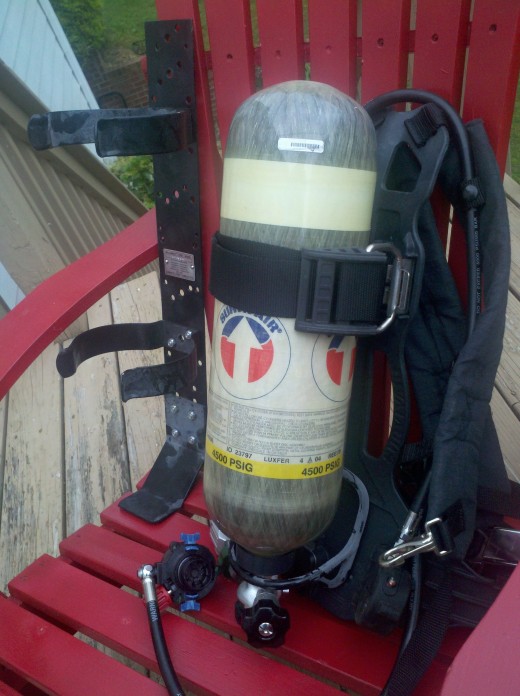PREPPING? Are you ready for fallout?

How to go from bunker to outside 1st time.
If you are one who is taking the idea of prepping seriously, what have you done to prepare for IDLH atmospheres? IDLH is defined as Immediately Dangerous to Life and Health. There are times when just an air filter or canister isn't enough - those units do not create oxygen (although there are O2 generators). Most gas masks simply have a pocket of active carbon to draw the air through. Carbon is very reactive to many of the pollutants and toxic gases and attaches itself to the toxic molecule allowing only the breathable air to pass on through to the user. Sometimes there isn't enough O2 (oxygen) in the atmosphere you are in - that is a minimum of 19% O2 to sustain life. When it drops below that level, you first pass out - then you die. Pretty simple.
Some gases aren't that toxic on their own, that is you probably breathe them in normally. For example, air that we normally breathe all day long is roughly 20.9% O2. It does vary with different pollutants taking up more space. The majority of the air you breathe is Nitrogen (N2) and it runs almost all of the rest - that is about 79%. Everything else is in that 0.01% that includes all of those other things we take in - from Hydrogen and Helium to Chlorine and so on. It is amazing that we must have at least 19% sustainable 02 to stay alert and functional. Below that can cause an array of problems usually ending in death. Only a difference of 1.9% change. So this is how generally thought of as non-toxic gases become killers.
Nitrogen, what we breath four times more of than Oxygen, will become toxic to us - that is kill us - if somehow 2% of the O2 is replaced with N2. N2 is used as a blanket to prevent rust (oxidation) or inhibit bacterial decomposition (rot) on food, or in food processing plants they purge the O2 and backfill with N2 and keep things from spoiling. Now that the O2 is either reduced or eliminated, someone walking into that room could not sustain themselves for long and would die.
Likewise, where there is fire danger, some companies utilize gases that are cheap and non-combustible such as CO2 to prevent explosions. This can be the case and CO2 pumped into a room to store items that may be otherwise a little shaky. A fire cannot be started in the room because there is no free O2 to all combustion. This keeps things safe - but if you were to walk into that room without an air supply, you would surely die.
Toxic Gases
Toxic gases are what we hear more about. Common industrial gases like Ammonia and Chlorine are the most common industrial gases and easily recognized. Ammonia and Chlorine are both used in water treatment and food processing plants for chilling (in the case of ammonia, as well as some cleaning) and disinfecting or cleaning in the case of Chlorine.
In sewer systems there is the decomposition of organic matter that leads to another gas known as Hydrogen Sulfide or H2S. Back in your high school chemistry class there was an experiment where the teacher usually caused a stir when they made some small amount of H2S as it smells like rotten eggs - it really stinks too. Well, it stinks until it gets above a certain level, the toxic level. At a certain point of concentration, H2S numbs your olfactory nerves, the nerve one has that give us a sense of smell. Then just after that, you die.
One of the unfortunate but most common incidents in the public safety arena comes when people are sent on a job working in sewer lines. The typical scenario is a three-man-team goes to a site. One individual lifts off a man-hole cover and descends into the sewer for some kind of work. His buddy is to set just outside and stay in touch so he can get tools or call for help if needed.
What usually happens next is the first guy in doesn't smell anything because the concentration of H2S is so high it has already numbed his sense of smell and he passes out and falls to the bottom of the shaft. His buddy, there to call for help, usually sees his friend fall and goes in after him to assist thinking he slipped off the ladder. In seconds, he is dead too. Usually the third guy is there to call the fire department who comes and enters the hole properly and retrieves both bodies.
How Does That Relate To Prepping?
In all of the discussions above I have been mentioning the need for, even for a 5 minute run, a source of air that has at least 19% O2. Filters on gas masks cannot generate O2. O2 generators do generate O2 -but are also creating a fire hazard. The best option is an SCBA - not a SCUBA, but SCBA - we don't need to plan to go under water (the U is the difference). An SCBA, self-contained breathing apparatus, can have a cylinder that can last from 30 to 60 minutes under non-stressed conditions. A fat guy under stress can suck a 30 minute cylinder empty in 10 minutes or less, so that is why I say under non-stressed conditions.
So having an SCBA in your prep plan would allow you the first opportunity after any kind of biological or chemical strike, the chance to go outside and inspect, see what was damage and assess conditions prior to actually breathing the air. This is a better chance of survival.
Of course if the air is just contaminated with dust or even known biological products - a P100 filter will handle that for a short duration along with a good quality gas mask. P-100 is a HEPA filter and can even remove "bird flu" or other virus contaminants.
If the level of O2 is satisfactory, that is above 19%, but there may be tear gas, or an ammonia or other gas leaking, it is possible you could use an MPC, that is multi-purpose canister that will give you 15 or so minutes of exposure time to be able to get through or around a problem.
Check it out on ebay or other sites, but consider this when prepping!
The Inventurist








